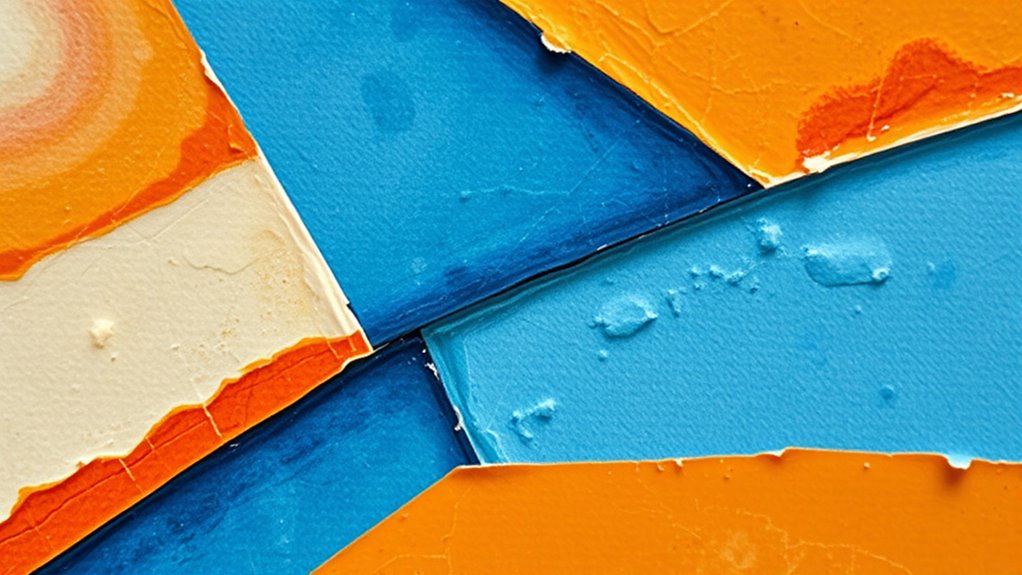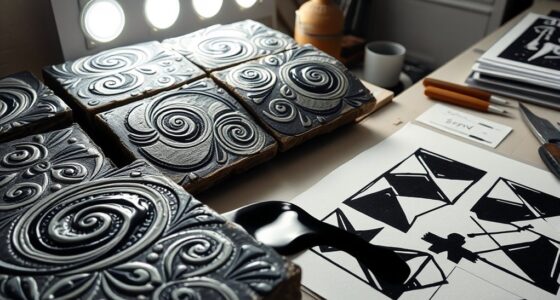Tempera painting, an age-old egg-based medium famed for its luminous colors and sharp detail, remains influential in contemporary art. Modern artists often revisit this technique to achieve unique textures, vibrant hues, and a matte finish that digital and oil methods can’t replicate. Using egg yolk as a binder, they create works that echo historical craftsmanship while exploring new visual possibilities. If you continue exploring, you’ll discover how this ancient method continues to inspire innovative artistic expressions today.
Key Takeaways
- Contemporary artists revive tempera for its luminous finish and precision, blending traditional techniques with modern themes.
- Egg-based mediums are used in mixed media artworks to achieve unique textures and vibrant, long-lasting colors.
- Modern tempera often combines egg binders with synthetic pigments for enhanced durability and versatility.
- Artists explore tempera to emulate historical styles or create contemporary interpretations with fine detail.
- Workshops and tutorials help artists adapt ancient tempera techniques for current artistic practices.

Have you ever wondered how artists created vibrant, long-lasting paintings before the advent of oil paints? The answer lies in tempera painting, a technique that dates back thousands of years and was favored by ancient civilizations like the Egyptians, Greeks, and Romans. During those times, artists relied on historical techniques that involved mixing finely ground pigments with a binder such as egg yolk, casein, or other organic substances. These mediums produced luminous colors and a matte finish, qualities that made tempera highly prized in its era. Despite the dominance of oil painting today, tempera persisted through the Middle Ages and the Renaissance, where master painters like Botticelli and Masaccio mastered its potential. Their artist adaptations included creating detailed, precise images with a distinctive clarity and sharpness that oil paints struggled to achieve at the time. They worked with quick-drying tempera, which allowed for fine detailing, layering, and glazing techniques that resulted in a luminous, almost ethereal quality. These adaptations were essential because they enabled artists to develop a unique style, emphasizing line work and meticulous detail that became hallmarks of tempera artworks.
In practice, tempera requires a different approach from oil painting. You’ll find that it dries rapidly, demanding swift, deliberate brushwork. Artists had to master the art of layering thin, semi-opaque colors to build depth and vibrancy. They often prepared their own pigments from natural sources, grinding minerals and plant dyes to achieve the desired hues. The egg binder not only held the pigments together but also contributed to the painting’s durability and luminous quality. Artists adapted to tempera’s fast drying time by working in small sections, often completing intricate details in a single session. This technique rewarded precision and control, which is why many early religious icons and altarpieces showcase its characteristic crisp lines and vibrant colors.
Today, contemporary artists are revisiting tempera because of its unique aesthetic and historical appeal. By understanding the historical techniques and artist adaptations of the past, modern practitioners can harness tempera’s qualities to create artwork that stands out for its luminosity and fine detail. Whether used as a primary medium or combined with other techniques, tempera offers a distinctive way to explore color, texture, and craftsmanship. Its enduring legacy demonstrates that even with modern innovations, traditional methods still hold an essential place in the art world, inspiring new generations to experiment with egg-based mediums and rediscover their timeless charm.
Frequently Asked Questions
How Does Tempera Compare to Oil Painting Techniques?
You’ll find that tempera differs from oil painting mainly in drying time and texture. Historically, tempera offers vibrant, matte finishes and requires quick work, while oil allows for blending and richer textures. Pigment analysis reveals tempera’s bright, stable colors, but it’s less forgiving for corrections. Oil paints, with their slow drying, give you more control and depth, making them popular for detailed, layered work.
What Are Modern Innovations in Egg Tempera Mediums?
Like Da Vinci’s timeless strokes, modern innovations in egg tempera bring fresh vigor. You’ll find digital integration enhancing precision and creative control, blending tradition with technology. Eco-friendly formulations also now prioritize sustainability, using natural ingredients that respect the environment. These advancements allow you to explore vibrant, durable artwork while reducing ecological impact, echoing the enduring spirit of innovation that continues to elevate egg tempera in contemporary art.
Can Tempera Be Used on Non-Traditional Surfaces?
Yes, you can use tempera on alternative surfaces like wood panels, canvas, or even textured materials. By experimenting with different surfaces, you create unique textures and effects that aren’t possible with traditional backgrounds. This flexibility allows you to push creative boundaries, combining tempera’s vibrant colors with experimental textures. Just prepare the surface properly to guarantee good adhesion, and you’ll open new possibilities for your artwork.
How Durable Are Tempera Artworks Over Time?
Your tempera artworks are quite durable if properly preserved. They resist aging effects like cracking and fading, especially when kept in stable conditions. To guarantee long-term art preservation, avoid excessive humidity and direct sunlight, and use professional framing techniques. Tempera’s fast-drying nature helps maintain its integrity over time, but regular monitoring and conservation efforts are essential to prevent deterioration and keep your pieces vibrant for many years.
What Are Common Challenges When Restoring Tempera Paintings?
When restoring tempera paintings, you face challenges like pigment instability and the delicate nature of the egg-based medium. You must carefully choose restoration techniques that avoid further damage, as tempera’s fragile surface can easily crack or flake. Ensuring pigment stability is vital, so you often use gentle cleaning and consolidation methods. Patience and precision are key, as improper restoration can compromise the artwork’s original vibrancy and integrity.
Conclusion
Now that you’ve explored tempera painting, you see how egg-based mediums still inspire modern artists, blending ancient techniques with contemporary themes. This timeless method proves that even in a world of NFTs and digital art, traditional mediums like tempera remain relevant and vibrant. Imagine Michelangelo scrolling through his tablet, still mastering the craft with egg yolk as his secret weapon. Embrace the enduring charm of tempera—where history and innovation beautifully collide in every brushstroke.









